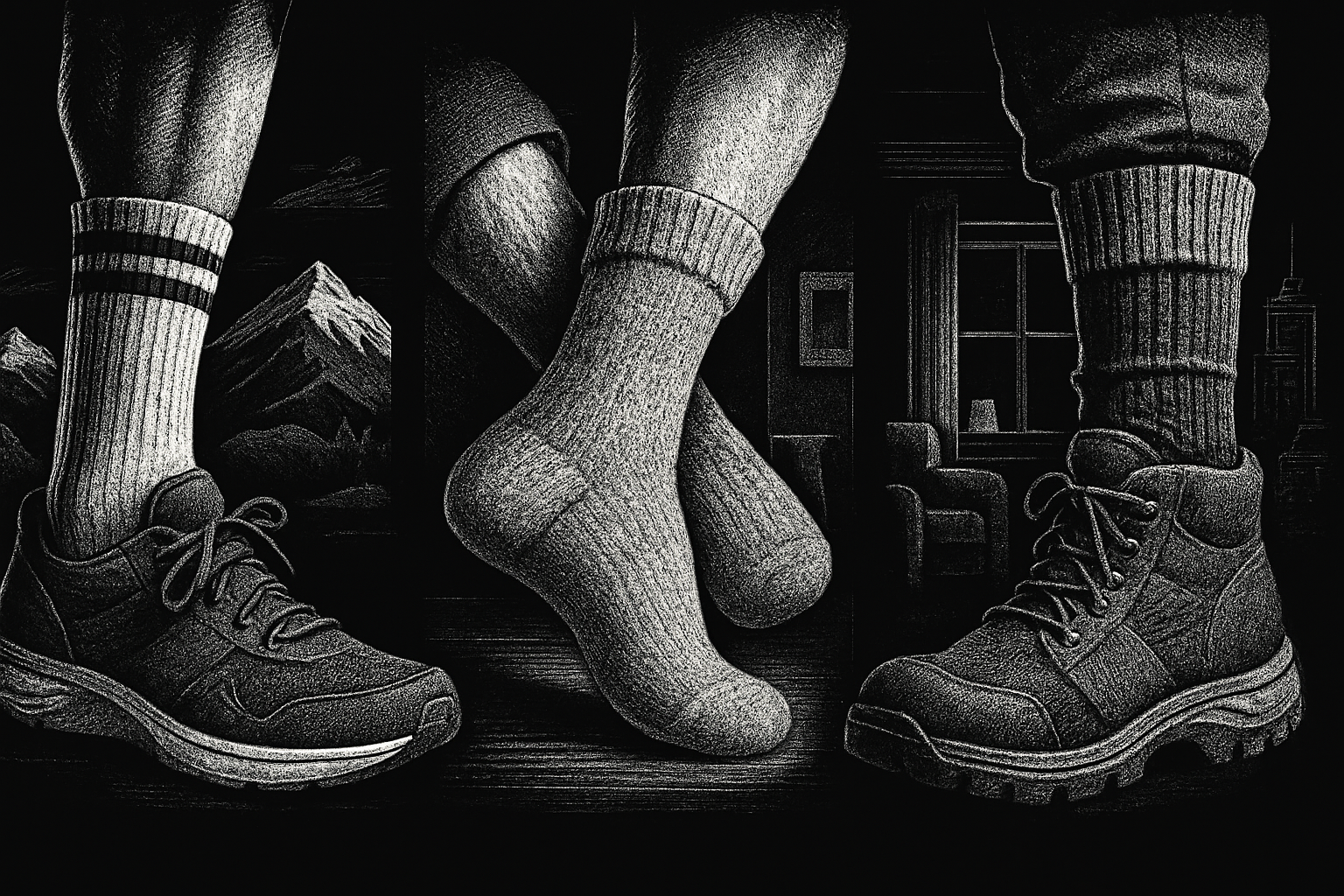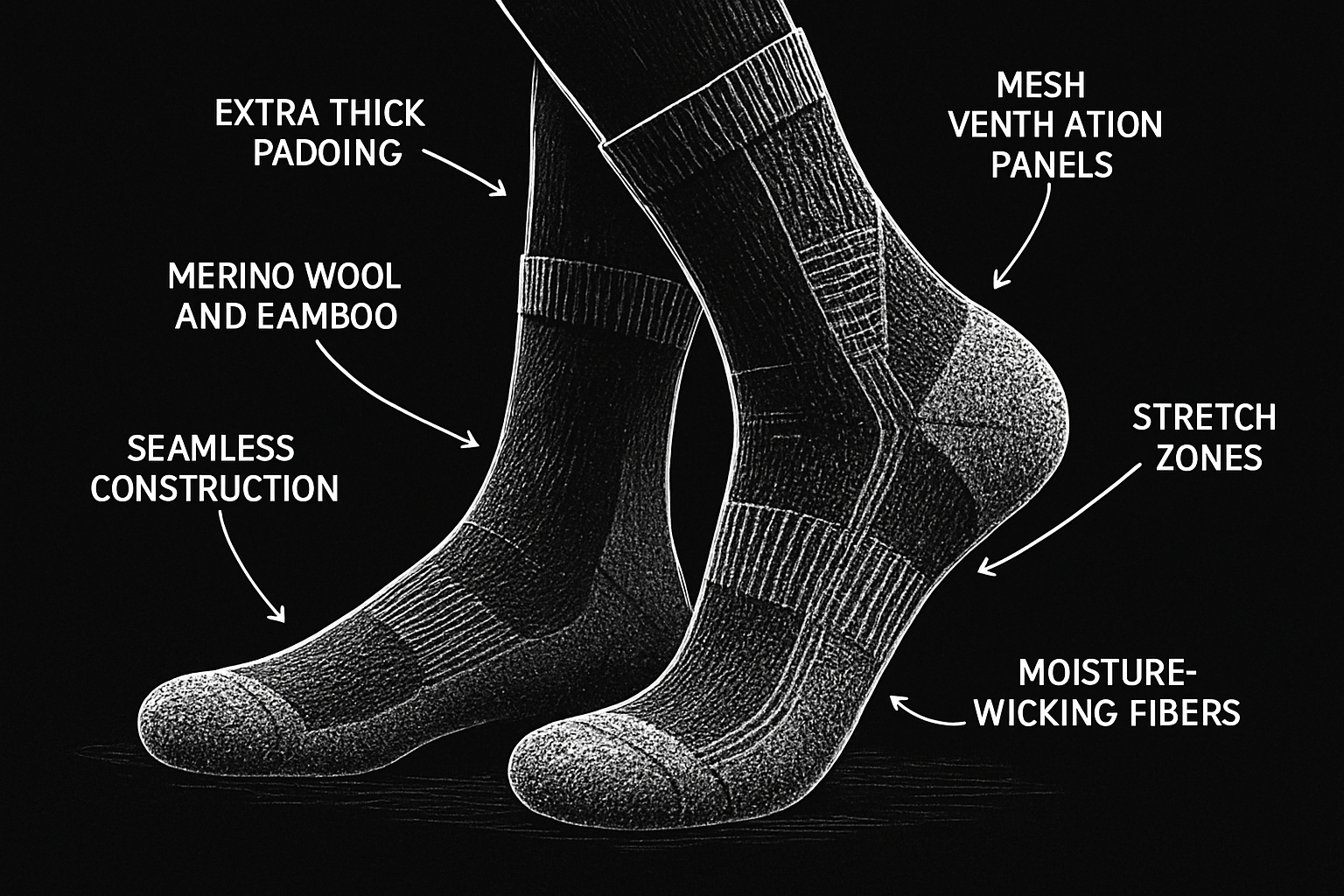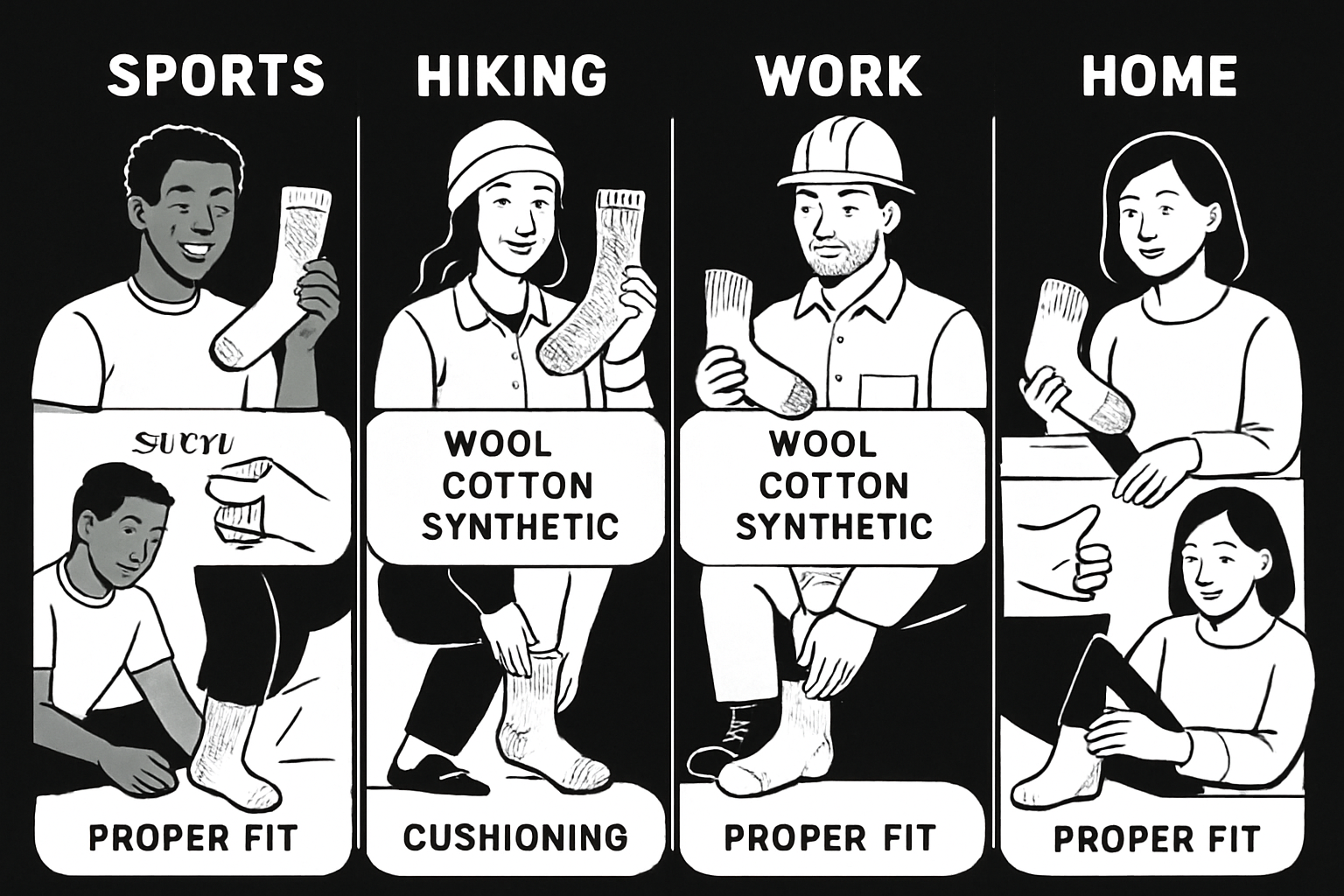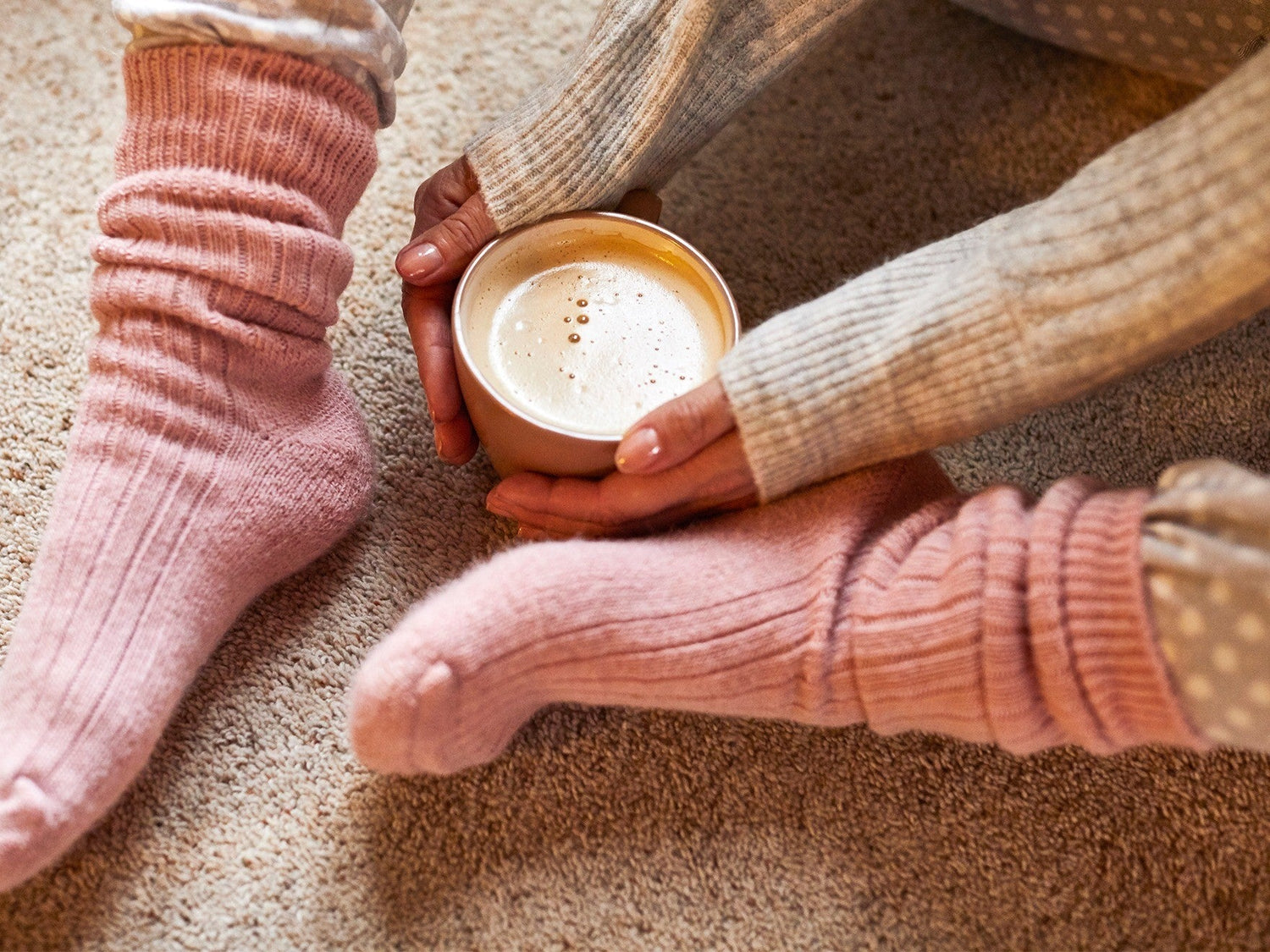Extra Thick Socks Guide: How to Choose in 2025
Are your feet always cold, sore, or tired? If so, 2025 might be the perfect year to discover the unmatched comfort and protection of extra thick socks.
This guide will walk you through everything you need to know, from the latest materials to advanced features and sizing tips. You'll learn how extra thick socks can transform your daily comfort, whether you're working, exploring the outdoors, or relaxing at home.
Get ready to explore real-world benefits and the newest sock technologies. By the end, you'll have the practical steps and confidence to choose the best pair for your needs.
Why Extra Thick Socks Matter in 2025
The importance of extra thick socks is surging in 2025, and it’s no passing trend. As lifestyles become more active and unpredictable, people are seeking comfort and protection for their feet like never before. Whether you’re commuting, exploring the outdoors, or simply relaxing at home, the right socks can transform your daily experience.

The Demand for Comfort and Protection
Comfort is king in 2025. As people spend longer hours on their feet—at work, during travel, or in outdoor pursuits—extra thick socks have become a daily essential. The demand is being driven by everyone from hikers and runners to warehouse workers, nurses, and seniors.
Why the shift? Consumers are prioritizing foot health and personal well-being. Thick socks offer a barrier against rough shoe interiors, cold weather, and long stretches of standing or walking. This focus on comfort and durability is making extra thick socks a staple for anyone wanting to prevent aches and fatigue.
Health Benefits and Common Foot Problems
The benefits of extra thick socks go far beyond simple warmth. Enhanced cushioning and support help absorb shock, protect joints, and reduce stress during movement. This is especially vital for those with sensitive feet, circulatory issues, or chronic pain.
Blisters, pressure points, and cold feet are common complaints that extra thick socks can address. For example, Orthofeet’s extra roomy socks are engineered for those with edema and circulation challenges, providing non-binding comfort and gentle support. Research also shows that sock choice matters: a sock type and foot lesions during hikes study found that well-designed, cushioned socks significantly reduce the risk of blisters and foot injuries during outdoor activities.
Evolving Trends and Market Insights
The extra thick socks market is booming. Sports enthusiasts are fueling the rise of maximum cushion socks, seeking protection for running, hiking, and skiing. Thorlo, a leading brand, now offers 42 different maximum-cushion products, reflecting a surge in demand among athletes, outdoor adventurers, and even military personnel.
Sales data shows seniors and those with medical needs are also turning to extra thick socks for added comfort. The trend is clear: these socks aren’t just for winter anymore—they’re year-round solutions for foot health, comfort, and performance.
Sustainability and Medical Considerations
Sustainability is shaping the future of extra thick socks. Eco-conscious shoppers are choosing socks made from organic cotton, recycled fibers, and responsibly sourced wool. Brands are responding with greener options that don’t sacrifice comfort or durability.
Medical needs are also expanding the audience for extra thick socks. Features like seamless interiors, anti-bacterial fabrics, and super-stretch designs are becoming standard, especially for those managing diabetes, edema, or sensitive skin. Orthofeet’s medical-grade socks are a prime example, offering advanced comfort for people who need it most.
In 2025, extra thick socks are more than a fashion statement—they’re a smart investment in daily comfort, protection, and health.
Key Features to Look for in Extra Thick Socks
Choosing the right extra thick socks in 2025 means understanding the latest features that deliver comfort, support, and durability. With new technologies and materials revolutionizing the market, knowing what to look for can make all the difference in your daily comfort and foot health.

Cushioning and Padding
Cushioning is the cornerstone of extra thick socks. Look for full-foot padding if you need all-around comfort or choose targeted zones—like heel, toe, or arch areas—for specialized support. Some socks even offer double-layer padding for maximum shock absorption.
This extra padding is vital for activities that put repeated stress on your feet, such as running, hiking, or long work shifts. By absorbing impact, extra thick socks reduce strain on joints and help prevent blisters and pressure points.
For example, Thorlo’s maximum cushion socks are engineered for high-impact sports, providing plush padding that protects against hard surfaces. With the right level of cushioning, your feet feel less fatigued, even after hours of wear. Whether you’re an athlete or on your feet all day, prioritize cushioning in extra thick socks for lasting comfort.
Materials and Fabric Innovations
The materials in extra thick socks have evolved dramatically. Natural fibers like merino wool, bamboo, and alpaca offer unique benefits. Merino wool is prized for its superb temperature regulation and softness. Bamboo is naturally hypoallergenic and boasts excellent moisture control, while alpaca is known for warmth and durability.
On the synthetic side, polyester blends provide outstanding moisture-wicking and long-lasting wear. Modern socks often combine these with new technologies such as DryPlex™ for rapid moisture evaporation and anti-bacterial or anti-odor treatments to keep feet fresh.
Competitors like Orthofeet use innovative blends, including BioSoft™ and Graphene, to enhance softness and maintain hygiene. When shopping for extra thick socks, consider how these material innovations can address your specific needs, whether it’s warmth, durability, or hygiene.
Fit, Stretch, and Sizing
A great fit is essential for extra thick socks. Non-constrictive knits and stretchy fibers ensure comfort and promote healthy circulation, especially if you have wide feet or conditions like edema. Seam-free construction is another must-have, as it prevents blisters and irritation often caused by bulky seams.
Brands like Orthofeet offer extra roomy socks with super stretch designs that adapt to changing foot sizes and shapes. Always consult size guides, especially when shopping online. If you’re unsure, refer to the detailed Sock Size Guide to find your best fit and make sure your socks won’t bunch or squeeze.
Fit also includes cuff design—look for non-binding cuffs that stay up without cutting into your calves. A proper fit in extra thick socks can make a noticeable difference in comfort and support throughout the day.
Breathability and Moisture Control
Despite their dense construction, today’s extra thick socks are engineered for breathability. Ventilation panels and advanced moisture-wicking systems pull sweat away from the skin, keeping your feet dry and comfortable during activity or long periods of wear.
This moisture control not only prevents that clammy feeling but also plays a crucial role in warding off fungal infections and odor. Technologies like the DryPlex™ system are designed to maintain a healthy foot environment, ideal for those with sensitive or diabetic feet.
Breathable extra thick socks are especially helpful for daily use and sports, as they reduce the risk of blisters and keep your feet feeling fresh. Prioritize socks that balance thick cushioning with smart ventilation for all-day comfort.
Top Uses and Applications for Extra Thick Socks
Are you wondering where extra thick socks truly shine? These socks are more than just a cozy accessory—they’re essential gear for a surprising range of activities and lifestyles. Whether you’re braving the outdoors, working long shifts, managing health concerns, or simply relaxing at home, extra thick socks can transform your comfort and foot health.

Outdoor Activities and Sports
When it comes to outdoor adventures, extra thick socks are game-changers. Hikers, skiers, runners, and walkers all benefit from the enhanced cushioning and warmth these socks provide. On rugged trails or snowy slopes, thick padding helps prevent blisters and pressure injuries, keeping feet comfortable mile after mile.
For hiking enthusiasts, choosing the right material is crucial. Mohair, for example, offers natural moisture-wicking and durability. If you’re curious about why mohair socks stand out for hiking, check out this resource on why mohair socks are best for hiking.
Athletes appreciate extra thick socks for their shock absorption during high-impact activities. The result? Reduced foot fatigue and fewer injuries, no matter how challenging the conditions.
Work and Occupational Needs
Jobs that demand long hours on your feet can take a toll. Nurses, warehouse staff, construction workers, and even those in military or industrial settings rely on extra thick socks for all-day support. The added cushioning helps absorb shock from hard surfaces, reducing pain and discomfort during extended shifts.
Many work-specific extra thick socks are designed with reinforced heels and toes for durability. Breathable fabrics help manage sweat, while snug fits prevent slipping inside heavy-duty boots. For anyone clocking in long hours, these socks can make the difference between aching feet and lasting comfort.
Health and Medical Benefits
Foot health is a priority for many, especially those with sensitive feet, circulation issues, or medical conditions like diabetes or edema. Extra thick socks provide a gentle, non-binding fit that supports circulation and reduces pressure points. Seam-free interiors and anti-bacterial materials are especially helpful for preventing irritation and keeping feet healthy.
Medical-grade extra thick socks can help manage swelling, protect against ulcers, and offer much-needed relief for those with neuropathy or other foot sensitivities. For anyone with health concerns, these socks are more than comfort—they’re a vital part of daily wellness.
Everyday Comfort and Home Use
Nothing beats the cozy comfort of extra thick socks for daily wear or lounging at home. They’re perfect for cold mornings, relaxing evenings, or anyone who struggles with cold feet. Elderly individuals, in particular, find these socks helpful for warmth and gentle protection around the house.
Bed socks and thick, casual designs make everyday life just a little bit softer. Whether you’re padding around on hardwood floors or curling up with a book, extra thick socks deliver warmth and comfort that lasts all day.
Step-by-Step Guide: How to Choose Extra Thick Socks in 2025
Ready to find your perfect extra thick socks? Follow this simple, step-by-step guide to make a confident choice in 2025. Whether you need extra cushion for sports, warmth for winter, or gentle support for sensitive feet, these seven steps will help you make the best decision for comfort, health, and performance.

Step 1: Assess Your Needs and Intended Use
Start by pinpointing why you need extra thick socks. Are you an avid hiker, a nurse on your feet all day, or someone dealing with cold toes at home? Consider your main activities, the climate you live in, and the shoes or boots you wear most often.
For example, winter hiking calls for maximum warmth and moisture control, while daily office wear may require moderate padding and breathability. Clarifying your needs ensures you select extra thick socks tailored for your lifestyle.
Step 2: Choose the Right Material
Materials impact comfort and performance. For warmth and softness, merino wool and bamboo are top choices, offering natural breathability and hypoallergenic benefits. Synthetics like polyester blends excel at moisture-wicking and durability—ideal for active use.
If you have sensitive skin, natural fibers can minimize irritation. When odor or sweat is a concern, prioritize anti-bacterial or moisture-wicking technologies. The right material ensures your extra thick socks meet your unique requirements.
Step 3: Evaluate Cushioning and Padding Levels
Not all extra thick socks provide the same level of cushioning. Decide if you need full-foot padding, targeted zones (like heel or toe), or double-layer protection. High-impact activities such as running or hiking benefit from maximum cushion, while moderate padding may suffice for office or casual wear.
For those wearing boots, understanding the ideal thickness and padding can prevent discomfort and blisters. Learn more in the Thick Socks for Boots Guide, which explains how sock thickness affects protection and durability in boots. Choose the right level to match your activity and foot sensitivity.
Step 4: Check Fit, Sizing, and Stretch
Proper fit is essential. Review brand-specific size charts and consider whether you need extra width or stretch, especially if you have wide feet or conditions like edema. Look for non-binding cuffs to support circulation and seamless interiors to prevent blisters.
If possible, try on extra thick socks before committing. Comfort comes from a sock that hugs your foot without constriction or bunching—never settle for less.
Step 5: Inspect Additional Features
Today’s extra thick socks come packed with advanced features. Look for moisture-wicking fabrics, anti-odor treatments, anti-blister technology, and reinforced heels or toes for durability. Check washing instructions—some socks are machine washable, while others need gentle care.
Innovations like DryPlex™ systems and inverse linking offer seam-free comfort and keep feet dry. Prioritize features that address your specific needs for all-day comfort.
Step 6: Compare Brands and Read Reviews
Now, weigh your options. Compare brands by examining ratings, user testimonials, and satisfaction guarantees. Some brands specialize in medical socks, while others focus on athletic or outdoor use.
| Brand | Key Features | Best For | User Rating |
|---|---|---|---|
| Thorlo | Max cushion, moisture-wick | Sports, work, outdoors | 4.9/5 |
| Orthofeet | Extra roomy, BioSoft™, DryPlex™ | Medical, sensitive feet | 5,000+ reviews |
Always check return policies and look for reviews from people with similar needs. An informed choice increases the odds of finding extra thick socks you’ll love.
Step 7: Make Your Purchase and Test for Comfort
Start with a single pair or a value bundle to test comfort during your typical activities. Pay attention to improvements in warmth, reduced fatigue, or less foot pain.
If the extra thick socks meet your expectations, consider purchasing more to rotate pairs and extend their lifespan. Your feet will thank you for the upgrade!
Care and Maintenance Tips for Extra Thick Socks
Caring for your extra thick socks properly will help you get the most out of every pair. With a little attention, you’ll enjoy all the warmth, cushioning, and comfort these socks provide, year after year. Let’s explore the best ways to keep extra thick socks in top shape.
Washing Extra Thick Socks
To maintain the plush feel and protective qualities of extra thick socks, follow these washing tips:
- Use a gentle machine cycle with cold or warm water.
- Avoid fabric softeners and bleach, which can break down fibers.
- Turn socks inside out to protect padded areas and reduce pilling.
- Place socks in a mesh laundry bag to prevent snags.
Here’s a quick comparison of washing methods for extra thick socks:
| Method | Pros | Cons |
|---|---|---|
| Gentle Machine | Easy, effective | May cause pilling over time |
| Hand Wash | Gentler on fibers | More time-consuming |
Drying and Storing for Longevity
How you dry and store extra thick socks impacts their durability:
- Tumble dry on low heat or, for best results, air dry flat to preserve elasticity.
- Avoid high heat, which can shrink or damage padding.
- Store socks folded (not rolled) in a cool, dry drawer to maintain their shape and softness.
Rotating your pairs ensures even wear and extends the lifespan of your extra thick socks.
Spotting Signs of Wear
Regularly inspect extra thick socks for:
- Thinning or worn-out areas, especially on heels and toes.
- Loss of stretch or sagging cuffs.
- Holes or visible damage.
Replace socks showing these signs to maintain comfort and support.
Odor, Hygiene, and Medical Considerations
To keep extra thick socks fresh:
- Choose socks with anti-odor or anti-bacterial properties.
- Wash after each wear, especially if used for sports or medical needs.
- For those with diabetes or sensitive feet, regular cleaning is even more important. Check out this systematic review on protective socks for people with diabetes to learn how proper sock care can help prevent foot issues.
Extending the Life of Your Extra Thick Socks
- Rotate between multiple pairs to reduce daily wear.
- Use laundry bags for machine washing.
- Avoid over-drying and harsh detergents.
When to Replace Your Socks
Swap out extra thick socks when you notice:
- Loss of cushioning or padding.
- Persistent odor, even after washing.
- Visible holes or irreversible stretching.
Proper care and maintenance ensure your extra thick socks stay comfortable, hygienic, and supportive—so you can enjoy every step.
Comparing Top Brands and Models for 2025
Choosing the right extra thick socks in 2025 can be overwhelming with so many brands and technologies on the market. To help you navigate this landscape, we’ve broken down the top contenders, their standout features, and what sets them apart for different needs.
Thorlo Maximum Cushion Socks
Thorlo stands out as a leader in extra thick socks, offering a vast 42-product range tailored for high-impact sports, demanding work environments, and cold climates. These socks are engineered with extra-thick padding designed to absorb shock and protect joints during intense activity.
You’ll find full-foot and targeted padding options, including reinforced heels and toes for durability. Thorlo’s proprietary moisture-wicking fibers help keep feet dry even during marathon runs or long hikes. Their maximum cushion socks are especially popular among athletes and outdoor enthusiasts, helping to reduce fatigue and prevent blisters.
User feedback is overwhelmingly positive, with an average rating of 4.9/5 stars. Many users report significant relief from foot pain and improved comfort during long shifts or challenging treks. The range covers all needs: crew, ankle, over-calf, and specialty socks for military or diabetic use. Prices vary from $10 for basic pairs to $60+ for performance bundles, offering options for every budget seeking extra thick socks.
Orthofeet Extra Roomy Socks
Orthofeet specializes in extra thick socks for medical and sensitive feet. Their designs focus on comfort for those with diabetes, edema, or circulatory concerns. The BioSoft™ and DryPlex™ fabrics deliver exceptional softness, moisture control, and anti-bacterial protection, making them ideal for anyone prone to swelling or skin irritation.
A standout feature is the non-constrictive, super stretch design, ensuring socks don’t impede circulation. Seam-free interiors reduce the risk of blisters, while wide-fit sizing accommodates various foot shapes. Customers praise Orthofeet for their thoughtful engineering and consistently report improved comfort, especially for swollen or sensitive feet.
Available in sizes from small to XL and colors like charcoal, black/gray, and dark brown, these socks come in 3-pair packs for $29.99, with bundle discounts. With over 5,000 glowing reviews, Orthofeet’s extra thick socks are a go-to for those seeking medical-grade comfort.
Other Notable Options
Several other brands offer excellent extra thick socks for specific needs. Look for merino wool blends if warmth and natural moisture management are priorities. Bamboo and alpaca fibers are also gaining popularity for their softness and hypoallergenic benefits.
Brands focusing on eco-friendly practices use recycled materials and sustainable production methods, catering to environmentally conscious buyers. For those prioritizing home comfort, extra thick bed socks have become a favorite for cold feet and cozy evenings. If you’re curious about how bed socks can improve sleep and warmth, check out this Bed Socks for Better Sleep guide.
When shopping for extra thick socks, always match your choice to your primary activities—whether hiking, working long shifts, or simply relaxing at home. Check for advanced moisture control technologies, such as DryPlex™ or similar, to keep feet healthy and comfortable.
How to Compare and Choose Between Brands
When comparing extra thick socks, focus on the features that matter most for your lifestyle. Start by evaluating the level of padding—maximum cushion is best for athletes and those on their feet all day, while moderate padding may suffice for office use.
Materials play a crucial role. Merino wool and bamboo offer natural softness and temperature regulation, while high-tech synthetics deliver moisture-wicking and durability. For those interested in how different fibers impact comfort and performance, this Running socks' role in comfort and microclimate study provides valuable insights.
Fit and sizing are equally important, especially for medical or wide feet. Seam-free construction and non-binding cuffs enhance comfort and reduce irritation. Compare user reviews and satisfaction ratings—Thorlo and Orthofeet consistently score high for both comfort and support.
Here’s a quick comparison table for reference:
| Brand | Padding | Materials | Fit/Sizing | Best For | Price Range |
|---|---|---|---|---|---|
| Thorlo | Max Cushion | Synthetic blends | Standard/Wide | Sports, Work | $10–$60+ |
| Orthofeet | Max Cushion | BioSoft™, DryPlex™ | Extra Roomy | Medical, Sensitive | $29.99+ |
| Others | Varies | Wool, Bamboo | Standard/Wide | Eco, Home, Hiking | $15–$40 |
Prioritize brands offering satisfaction guarantees and flexible return policies. Ultimately, the best extra thick socks are those that address your primary needs—whether that’s athletic performance, medical comfort, or everyday warmth.
Frequently Asked Questions About Extra Thick Socks
Do you have questions about extra thick socks? You’re not alone. Here are the most common concerns and answers to help you make the best choice for comfort, health, and daily wear.
What makes socks “extra thick” compared to regular socks?
Extra thick socks feature significantly more cushioning and padding than regular or moderately cushioned socks. This extra bulk is found in the sole, heel, toe, and sometimes the entire footbed, providing superior shock absorption and warmth. The design helps protect feet from blisters and pressure points during extended wear.
Are extra thick socks suitable for year-round wear, or just for winter?
While extra thick socks are popular in cold weather, many are engineered with moisture-wicking and breathable materials for year-round comfort. Look for lighter-weight thick socks for summer or indoor use, and heavier options for outdoor winter activities. Modern designs ensure feet stay comfortable and dry in any season.
Can extra thick socks help with foot pain, blisters, or medical conditions?
Yes! Extra thick socks can relieve foot pain by providing cushioning and reducing friction. They’re especially helpful for those with diabetes, neuropathy, or sensitive skin. Some medical-grade options are designed for edema or circulation issues, using non-binding cuffs and seamless construction to prevent irritation and support overall foot health.
How do I know if my socks are too tight or too loose?
Proper fit is essential. Extra thick socks should feel snug without constricting your circulation or causing indentations. If socks leave deep marks or feel restrictive, try a larger size or a brand offering extra stretch. Loose socks may bunch up, increasing the risk of blisters or instability. For those concerned about balance, see this study on orthopedic insoles and thick socks.
What materials are best for sensitive skin or allergies?
Natural fibers like merino wool, bamboo, or cotton are excellent for sensitive skin. These materials are soft, hypoallergenic, and help regulate moisture. Look for extra thick socks labeled as “seam-free” or “anti-bacterial” to minimize irritation and prevent odor. Always check material labels if you have known allergies.
How often should I replace extra thick socks?
Plan to replace extra thick socks once they show thinning, loss of stretch, or holes—typically every 6–12 months with regular use. Rotating between several pairs extends their lifespan. Worn-out socks lose cushioning and may no longer protect your feet effectively, so inspect them regularly for signs of wear.
Are there eco-friendly or sustainable thick sock options?
Yes, many brands now offer extra thick socks made from sustainable materials like organic cotton, bamboo, or recycled fibers. These options minimize environmental impact while providing the same comfort and durability. Check for certifications or eco-friendly labels when shopping for your next pair.
Do thick socks fit in all types of shoes and boots? Tips for best fit?
Extra thick socks may require a bit more room in your shoes. If your footwear feels tight, consider going up half a size or choosing shoes with adjustable lacing. For boots, especially hiking or work boots, thick socks often enhance fit and comfort. Always try socks with your intended footwear before purchasing.
Still have questions about extra thick socks? Reach out to brands or consult a foot care specialist for personalized advice. The right pair can make all the difference in daily comfort and foot health.


